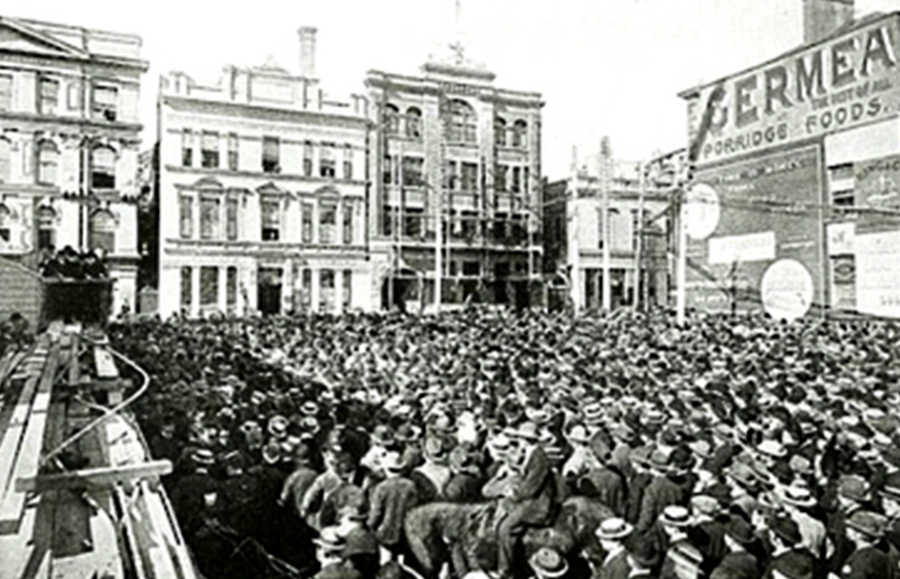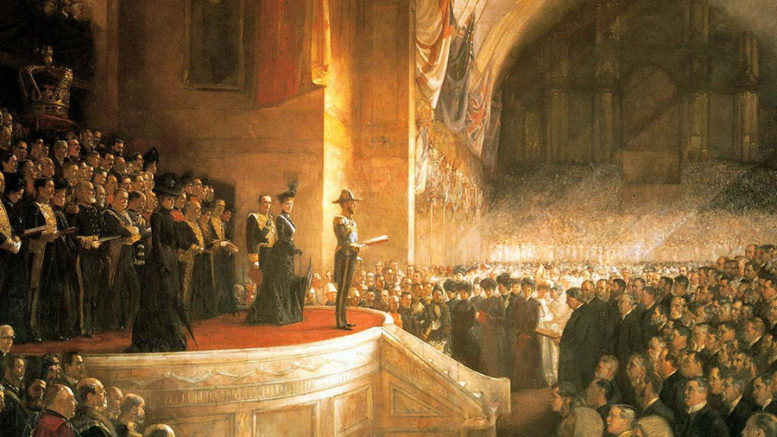Although Australia Day was some weeks ago, the controversy persists and ongoing discussion on the date and what for, continues to be of major importance for Australia.
Contributed by Glen Davis
Another Australia Day on January 26 has come and gone. A day in which English troops landed on the land of the Eora people in what is now called Sydney Cove, that is somehow meant to symbolise the founding of a nation.
As it was, the nation called Australia only goes back to Federation on January 1, 1901

Early pro-federation rally at Martin Place in Sydney
On March 3, 1986, the Federal Governments Australia Act came into force. There were two separate Acts, one passed by the Federal Parliament of Australia, the other by the Parliament of the United Kingdom. (These were signed simultaneously on March 2 by Australian Prime Minister Bob Hawke, and Queen Elizabeth II).
Both worked to provide a formal Australian independence almost entirely separate from England’s United Kingdom or reduce overt English involvement in Australian Judicial and Political matters to a minimum.
The Act aimed to bring constitutional arrangements affecting the Commonwealth and the
Australian States into conformity having the status of the Commonwealth of Australia being a sovereign, independent, and federated nation. The Australian Commonwealth and its states had broken any constitutional ties to the United Kingdom to obtain a level of independence.
Thus, as it ended any further possibility the United Kingdom had to legislate for Australia.
It also removed the prospect for an Australian court of launching an appeal to a British court. How many of us are aware that in 1979 the elected NSW Government were instructed by Buckingham Palace not to submit bills to their State Parliament and alter the Queens powers to appoint State Governors and the role of England’s Privy Council to act on appeals from the State courts?
In many ways this was the final straw leading to the Australia Act of 1986
Despite all this, the Australian Head of State is still Queen Elizabeth II, Queen of England. The current Australian Constitution delegates her powers to her Australian Representative, the Governor General.

Photo by Toby Melville/AFP: Queen of England remains head of state of Australia
In 2021 you seriously wonder about Australia’s political maturity when this structure remains in place.
As a young political activist back in 1986. The proclamation of the Australia Act didn’t have much resonance with me. I would much rather seen the English Royal family abdicate, or anything else that would remove them from our lives.
Now many moons later, I am thinking, is there something about this Act that can be a basis of a national day? If the Act is a legislative, political declaration of Australia becoming an independent nation, is it worth celebrating?
The current question/debate is around what day we should call Australia Day, but maybe the question should be is do we really need an Australia Day?


Your article accurately states, “As it was, the nation called Australia only goes back to Federation on January 1, 1901”.
THIS & ONLY THIS DAY IS THE TRUE “AUSTRALIA DAY” — for good or for bad or whatever in between. There IS NO ARGUMENT. Another day may be chosen to celebrate, that is a different matter, but why the hell bother to do this? Celebrate or not on the REAL AUSTRALIA DAY!!
For us in Australia, we need a REAL AUSTRALIAN “AUSTRALIA DAY” not some tin-pot hangover from the colonial domination.
Australia Day should have real meaning, MEANING THAT IS REPRESENTATIVE OF THE HISTORY OF AUSTRALIAN PEOPLE & OUR STRUGGLES!!
We need a day which is to do with OUR STRUGGLES AGAINST BRITISH OPPRESSION. To that end the struggle marked by the Eureka Stockade events should be ‘OUR DAY’, it is the first real AUSTRALIA DAY. They were attacked on Sunday December 3 by the troopers.
This is a short overview of that event.
On November 30 many of the diggers organized themselves into military companies and elected Peter Lalor, one of the Reform League’s representatives, as their commander in chief. Work then began on the stockade. Troops and police surrounded the 150 diggers who were within the structure on December 3. After refusing to come out, the diggers opened fire on the government forces. The ensuing battle lasted for 15 minutes and ended with the rout of the diggers. Although there is some uncertainty concerning the death toll, it is generally believed that 22 diggers and 5 troopers were killed. Lalor escaped and remained in hiding until amnesty was declared. None of the rebels accused of treason was convicted. The Eureka Stockade rising accelerated the enactment of reforms, which followed in 1855.
LET US CONTINUE BUILD ON THAT EFFORT TODAY & EVERY DAY WE LIVE !!